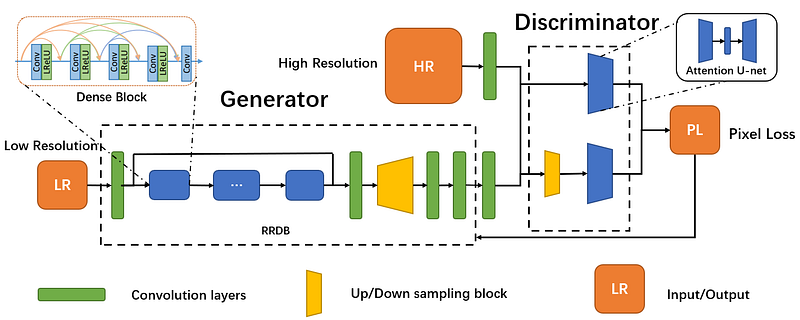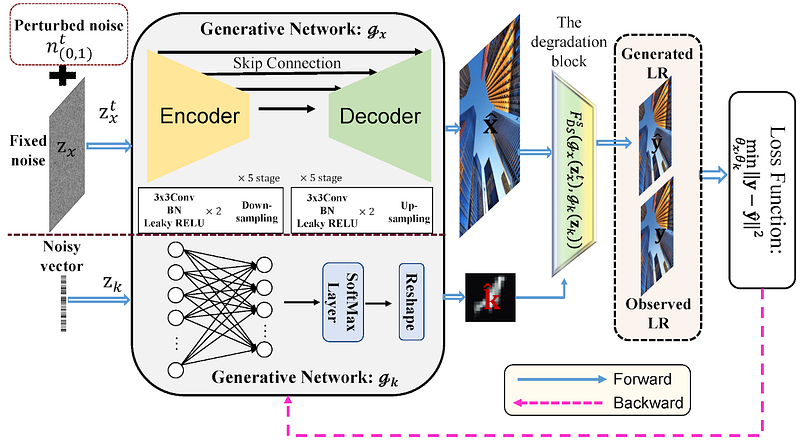Blind Super Resolution Generative Adversarial Network(BSRGAN)
Blind Super Resolution Generative Adversarial Network(BSRGAN)
Easy:
Imagine you have a super special toy camera that can take pictures of things that are too far away or too blurry for your regular camera to capture clearly. But sometimes, when you try to take a picture with this special camera, it doesn’t work perfectly because the image is still not clear enough.
Now, let’s say there’s a magical friend who loves puzzles and games. This friend has a magic wand that can help make those unclear images clearer. The magic wand works in a very special way: it looks at the blurry image from the special camera and tries to guess what the image should look like if everything was perfect. It then draws over the blurry image with its magic, making it clearer and more detailed.
But here’s the twist — our magical friend doesn’t just randomly draw on the image. They play a game where they try to trick another magical friend into thinking the new, clearer image is real and not something they made up. If the second magical friend can’t tell the difference between the original blurry image and the one that got magically enhanced, then our first magical friend wins!
This whole process is like how a Blind Super Resolution Generative Adversarial Network (GAN) works. It uses computers to do what our magical friends do but much faster and more accurately. The computer looks at blurry images, tries to make them clearer, and then tricks another part of the computer into thinking the clearer image is real. If the computer can’t tell the difference, then the network knows it did a good job.

Moderate:
Blind Super Resolution Generative Adversarial Networks (GANs) are advanced tools used in the field of artificial intelligence and machine learning. They are designed to enhance the quality of low-resolution images, making them appear as if they were captured in high resolution. Let’s break down how this technology works, focusing on its key components and processes.
What is a Generative Adversarial Network (GAN)?
At the heart of blind super resolution GANs is the concept of GANs themselves. A GAN consists of two parts:
- Generator: This is like the magical friend I mentioned earlier. Its job is to create new data instances, such as images, that look similar to some training set. In the context of blind super resolution, the generator takes a low-resolution image and tries to produce a higher resolution version of it.
- Discriminator: Think of the discriminator as the second magical friend. Its role is to distinguish between real and fake data. For example, if the generator produces an image, the discriminator will try to determine whether this image is a real high-resolution image or a fake one created by the generator.
How Does Blind Super Resolution Work?
The “blind” aspect of blind super resolution refers to the fact that the network does not require paired examples of low- and high-resolution images during training. Traditional super resolution methods often need pairs of low- and high-resolution images to learn how to upscale and improve the quality of images. However, blind super resolution GANs can work with single low-resolution images alone, making them more flexible and efficient.
Here’s a simplified overview of the process:
- Training Phase:
- The generator starts by creating a high-resolution version of a low-resolution image.
- The discriminator evaluates this generated image against real high-resolution images. It tries to determine if the image is real or fake.
- Both the generator and discriminator are trained together. The generator learns to create better high-resolution images, and the discriminator learns to become better at distinguishing between real and fake images. - Inference Phase:
- Once trained, the generator can take any low-resolution image and produce a high-resolution version without needing a corresponding high-resolution image as input.
Why Is It Important?
Blind super resolution GANs are significant because they can significantly improve the quality of digital images, especially in applications where high-quality images are crucial but obtaining them is challenging or expensive. This technology finds use in various fields, including medical imaging, satellite imagery, and photography, enhancing the detail and clarity of images for better analysis and interpretation.
In summary, blind super resolution GANs are sophisticated AI models that can enhance the resolution of images without needing high-resolution counterparts for training, making them powerful tools for improving image quality across different domains.

Hard:
Sure, let’s dive a bit deeper into Blind Super Resolution Generative Adversarial Network (BSRGAN) while keeping it accessible.
Understanding the Basics
- Super Resolution: This is a process of enhancing the resolution of an image, making it sharper and more detailed. It’s like zooming in on a photo and making sure it still looks clear.
- Generative Adversarial Network (GAN): This is a type of artificial intelligence that has two parts:
- Generator: Tries to create realistic images.
- Discriminator: Tries to tell the difference between real images and the images created by the generator.
Blind Super Resolution
“Blind” in this context means that the system doesn’t know in advance what kind of blurriness or degradation the input images have. The system has to work with whatever it gets and still produce a clear, high-resolution image.
How BSRGAN Works
- The Generator (Fixer):
- The generator receives a low-resolution (blurry) image.
- It tries to create a high-resolution image that looks realistic and detailed.
- It uses learned patterns and details from high-resolution images to fill in the gaps. - The Discriminator (Checker):
- The discriminator receives both real high-resolution images and the images generated by the generator.
- It tries to distinguish between the real images and the generated images.
- It provides feedback to the generator on how realistic the generated images look. - Training Process:
- During training, the generator and discriminator are in a constant game where the generator improves its ability to create realistic images, and the discriminator gets better at spotting fake images.
- Over time, the generator produces increasingly realistic high-resolution images from low-resolution inputs.
Key Points of BSRGAN
- Adaptability: BSRGAN can handle various types of image degradation without needing specific information about the type of blur or noise. This makes it versatile and effective in real-world scenarios where the type of image degradation is unknown.
- Detail Enhancement: By learning from a vast number of high-resolution images, BSRGAN can infer and reconstruct fine details that are not present in the low-resolution images.
- Adversarial Training: The use of a discriminator ensures that the generated high-resolution images are not just mathematically improved but also look visually convincing to human eyes.
Practical Applications
- Photography: Enhancing old or blurry photos to bring out more detail.
- Security: Improving the quality of surveillance footage to better identify faces or objects.
- Medical Imaging: Enhancing low-resolution medical scans for better diagnosis.
In essence, BSRGAN is a powerful tool in the field of image processing that leverages the strengths of GANs to improve the quality of images in a blind and adaptive manner, making blurry images sharp and detailed regardless of the type of blur they start with..

Comments
Post a Comment